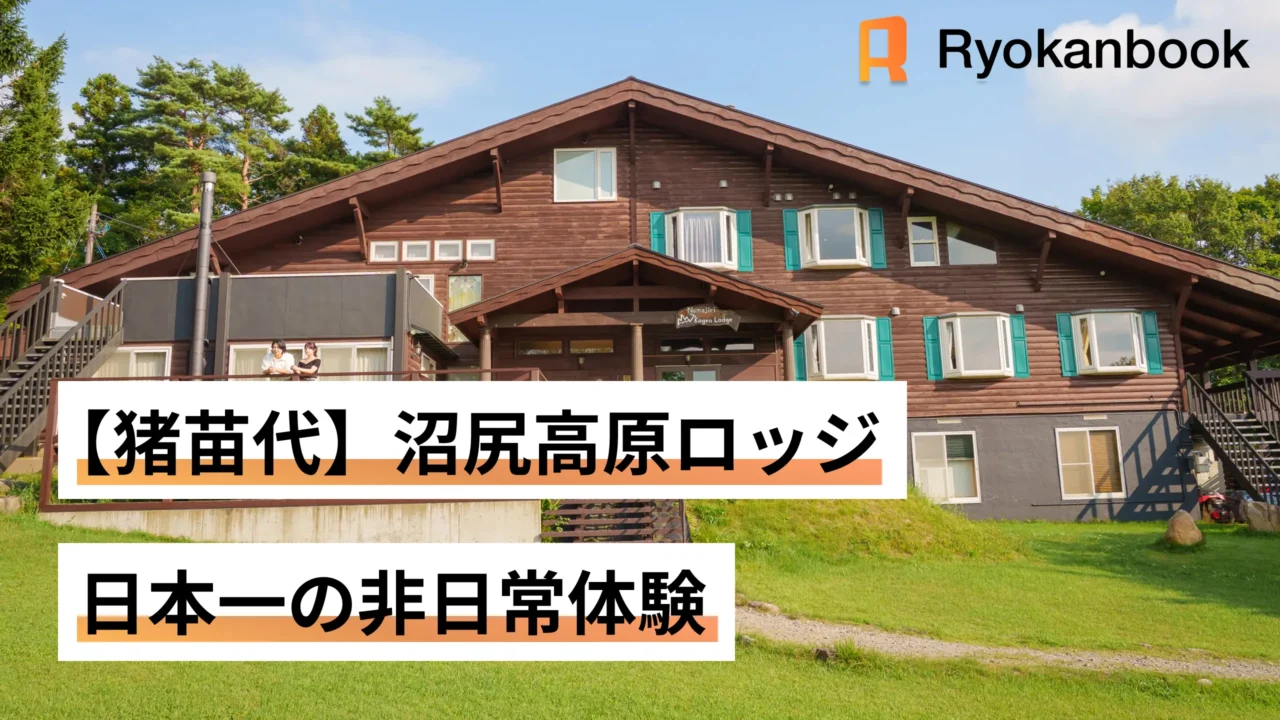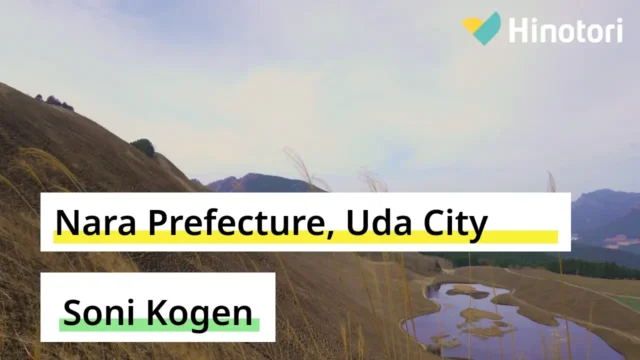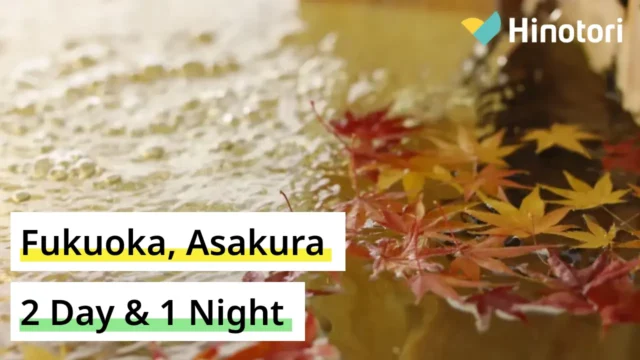What people seek in a journey varies greatly.
Some long to escape the noise of everyday life and unwind in the quiet of nature, while others crave new sights and active adventures that stir the soul.
In the hidden heart of Inawashiro, Fukushima, there exists a place where these seemingly opposite desires — healing and adventure — can both be fulfilled in just two days. That place is Numajiri Kogen Lodge, a tranquil retreat nestled deep in the forest, and Extreme Onsen, an unparalleled experience for those who seek the ultimate thrill in nature.
Numajiri Kogen Lodge feels like a private villa tucked away in the woods.
Here, there is no rush of time, no trace of daily commotion — only a gentle harmony with the surrounding wilderness. As you gaze out at the meadow and forest beyond the window, the fast-paced rhythm of city life slowly fades away.
Then, the next day brings a completely different kind of experience: trekking through mountains, descending into valleys, and immersing yourself in a wild open-air hot spring where the natural spring water gushes directly from the source. It’s an awe-inspiring adventure — a true journey that can only be lived by stepping fully into nature, far beyond the reach of ordinary sightseeing.
Healing and adventure. Serenity and excitement.
In Numajiri, both coexist in perfect balance — offering an extraordinary escape like no other.
▷Learn more about the NUMAJIRI PLATEAU LODGE
- Check into a Forest Hideaway
- ① Lounge & Guest Rooms — A Peaceful Retreat in Harmony with the Forest
- ②Dining & Onsen — Moments That Capture the Spirit of a Traditional Ryokan
- ③Campfire — A Night of Reflection Amidst Silence and Nature
- Extreme Onsen Experience — A Day That Shifts from Serenity to Adventure
- Trekking — The Adventure Begins Toward a Hidden Hot Spring
- Extreme Onsen
Check into a Forest Hideaway

The area around Lake Inawashiro in Fukushima is known for its serene and tranquil atmosphere.
Yet, as you drive deeper into the mountains, the scenery begins to transform. The townscape gradually fades away, giving way to winding roads through the forest. Then, suddenly, the view opens up before you
— a vast meadow seemingly floating in the midst of the woods.
In one corner of this open landscape stands a quietly nestled building — Numajiri Kogen Lodge.There are no houses or shops nearby, only a calm and liberating atmosphere that surrounds the area.
The scenery evokes the feeling of a European mountain retreat, peaceful and picturesque.
This lodge holds a rather special story.
The building was once cherished by Junko Tabei, the first woman in the world to summit Mount Everest, who used it as her personal mountain retreat. Throughout her life, she had a deep affection for the natural beauty of Numajiri, often setting out from here to explore the surrounding peaks. Honoring her legacy, the historic inn Okawaso has inherited and carefully renovated the property. Today, it has been reborn as a unique lodge where ordinary travelers, too, can stay and experience the same tranquility and inspiration that once captivated Tabei herself.
Stepping through the entrance, I was greeted by staff with warm, gentle smiles.
Though it was my first visit, a sense of nostalgia and comfort washed over me, as if I had returned to a familiar place.
Inside, the lodge features an elegant wooden interior that blends seamlessly with the surrounding nature. The space exudes calm and refinement — modern in its amenities, yet filled with a soothing warmth that makes you feel instantly at ease.
① Lounge & Guest Rooms — A Peaceful Retreat in Harmony with the Forest
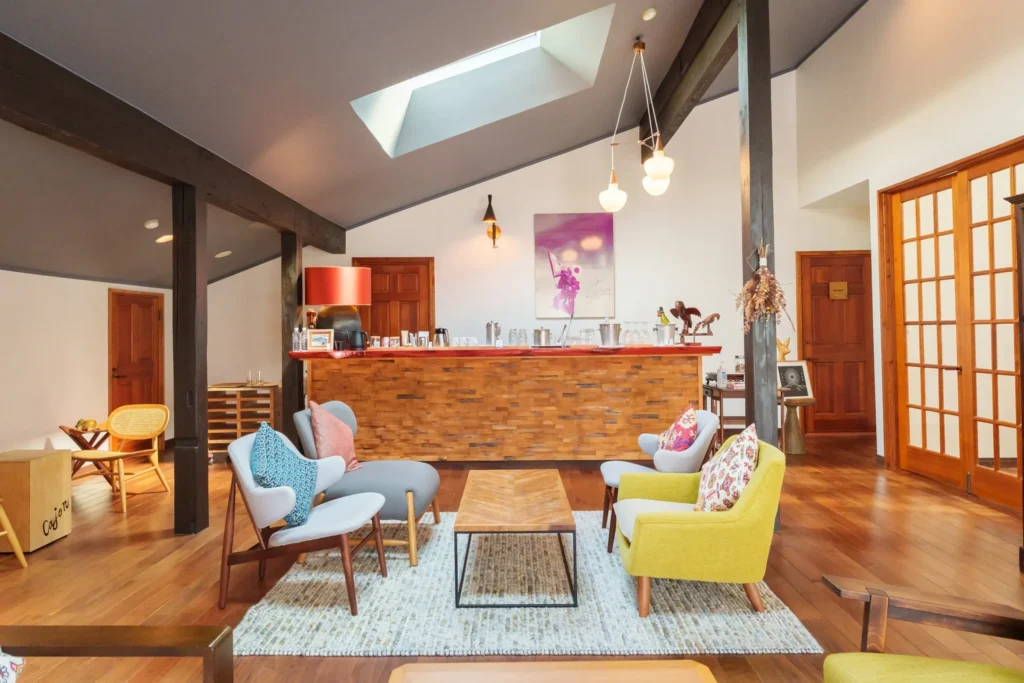
The first thing that captured my heart upon entering was the lounge located on the second floor, just beyond the lobby.
Filled with displays and books related to the mountaineer’s life, the space is wrapped in the warmth of wood, where a gentle, unhurried flow of time seems to drift quietly by.
Here, guests can enjoy complimentary drinks — from coffee and wine to whiskey and local sweets. Settle into a sofa by the window, and you can savor a leisurely moment while gazing out over the serene highland scenery.

The guest rooms, too, are an essential part of what makes this lodge so special.
Neither like a white-toned modern hotel nor a rustic traditional house, each room strikes a perfect balance between wooden warmth and contemporary design. The result is a space that feels both refined and inviting — as if you’ve been welcomed into a private chalet tucked away in the snowy mountains.

The rooms are spacious, seamlessly blending with the vast highland scenery outside the windows to create an exceptional sense of openness.
Guests can choose from various room types — such as the Suite Room with a semi-open-air bath or the expansive Special Twin Room — depending on group size and travel style.
As your gaze naturally drifts toward the view outside, you become enveloped in the shifting light and landscape. It’s a feeling as if the boundaries between yourself and the forest gently dissolve, leaving only pure tranquility.
②Dining & Onsen — Moments That Capture the Spirit of a Traditional Ryokan
When it comes to what lingers in your heart after a journey in Japan, it’s undoubtedly the food and the hot springs.
At Numajiri Kogen Lodge, dinner is a refined Japanese course meal that celebrates the seasonal blessings of Fukushima and the Tohoku region. Each dish reflects deep respect for nature and trust in the local producers, leaving a lasting impression.
Here are three standout dishes that particularly stayed with me.
Dinner — A Japanese Course Showcasing the Seasonal Flavors of Tohoku
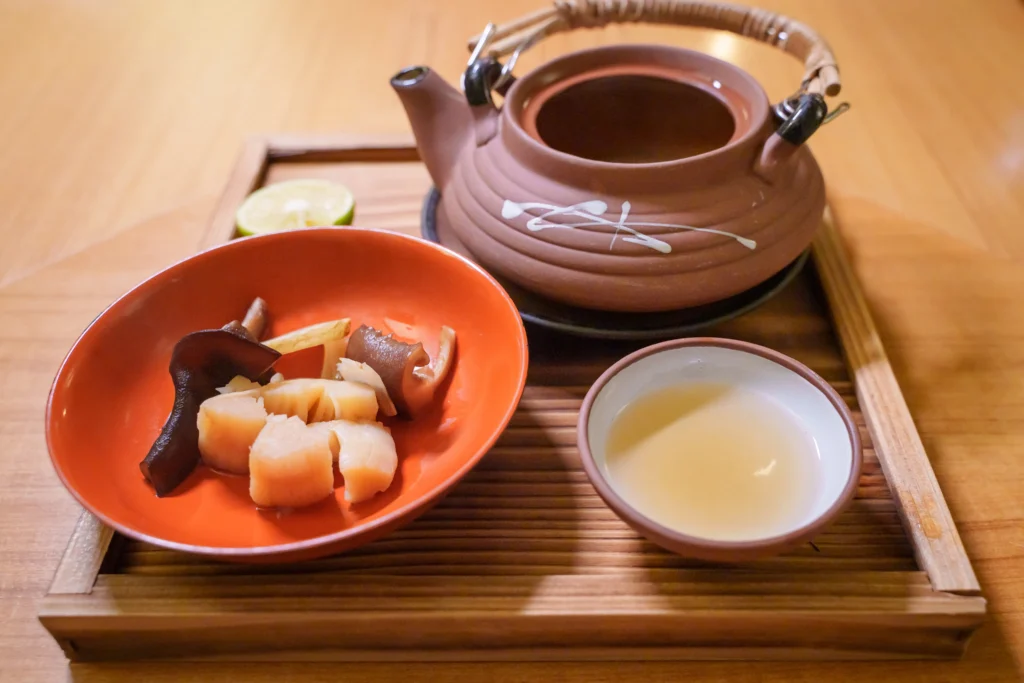
The first dish to arrive was beautifully presented:
“Medicinal Soup with Inawashiro Maiko Mushrooms, Aizu Fresh Wood Ear, Aizu Carrots, and Jerusalem Artichokes — Dōbin-mushi Style.”
※ Dōbin-mushi : A traditional Japanese soup served in a small teapot (dōbin), where ingredients are steamed and the fragrant broth is poured into a cup to drink.
It was unbelievably delicious.
First, I poured just the clear broth from the teapot into a small cup. The moment I took a sip, the gentle aroma of hishi-cha and maitake mushrooms drifted through my nose, and warmth spread deep into my body. The soup stock, made from Aizu-dried scallops combined with hishi-cha, carried a rich, nourishing depth — gentle yet full of character.
The head chef explained, “Serving something warm at the start helps prepare the stomach and ease the body into the meal.”
From the very first sip, I could feel the spirit of the land and the vitality of its ingredients — a truly memorable beginning to the dinner.

Next came “Fresh Sanriku Scallop and Summer Flounder.”
The chef slices the seafood just before serving to minimize oxidation, bringing out the natural sweetness and translucent freshness of each ingredient.
“Shellfish and fish are sweetest when cut while still alive. The longer you wait, the more off-flavors develop,” the head chef explained.
True to his words, the scallops were plump and springy, while the flounder offered a soft, delicate umami that gently spread across the palate. Instead of using rich soy sauce, the dish was served with light soy sauce blended with kelp dashi, enhancing the oceanic aroma without overpowering it.
It was a pure, harmonious dish — a perfect balance between the sea, the chef, the ingredients, and the mastery of technique.
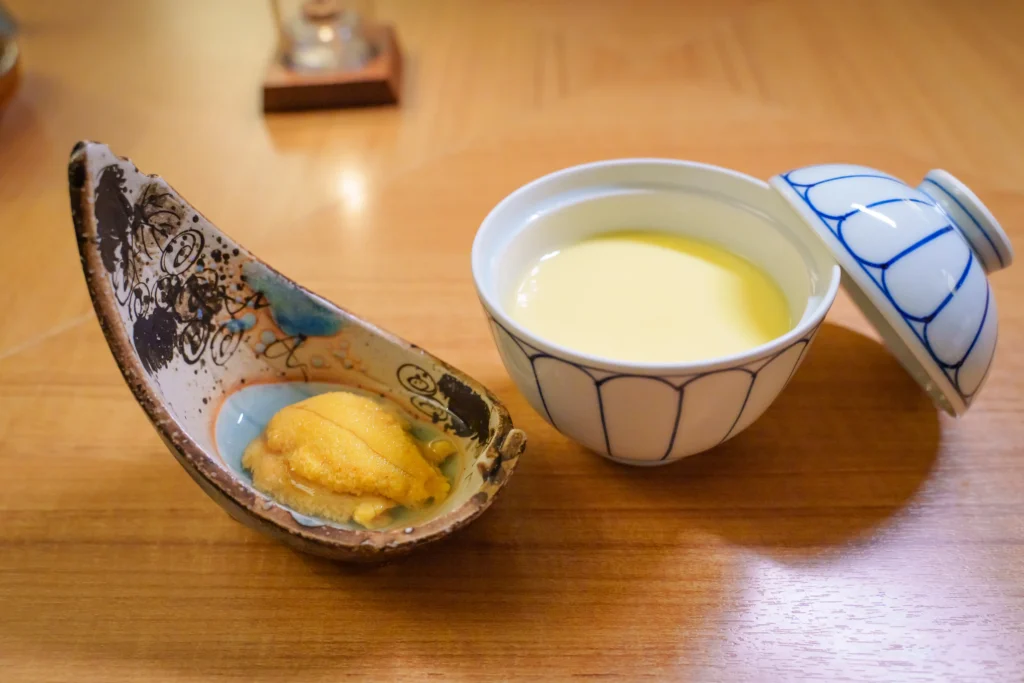
Finally came “Fresh Sanriku Sea Urchin in Rausu Kelp Broth with Steamed Aizu Jidori Egg Custard.”
Sea urchin (uni) can be polarizing — many people find it challenging to enjoy. In fact, I’m one of those Japanese who isn’t naturally fond of uni.
Yet there was not a hint of the usual brininess — the uni was rich and creamy, almost like butter.
“With the gentle umami of kelp broth and Aizu Jidori eggs, we want to envelop the flavor of the uni,” the head chef explained.
True to his words, the savory notes of sea and land quietly melded together, creating a dish with a lingering, memorable finish.
※ Aizu Jidori: A local free-range chicken from Aizu, prized for its firm texture and rich, natural flavor.
The Chef’s Philosophy — Crafting Dishes That Celebrate the Land and the Seasons
The course also included:
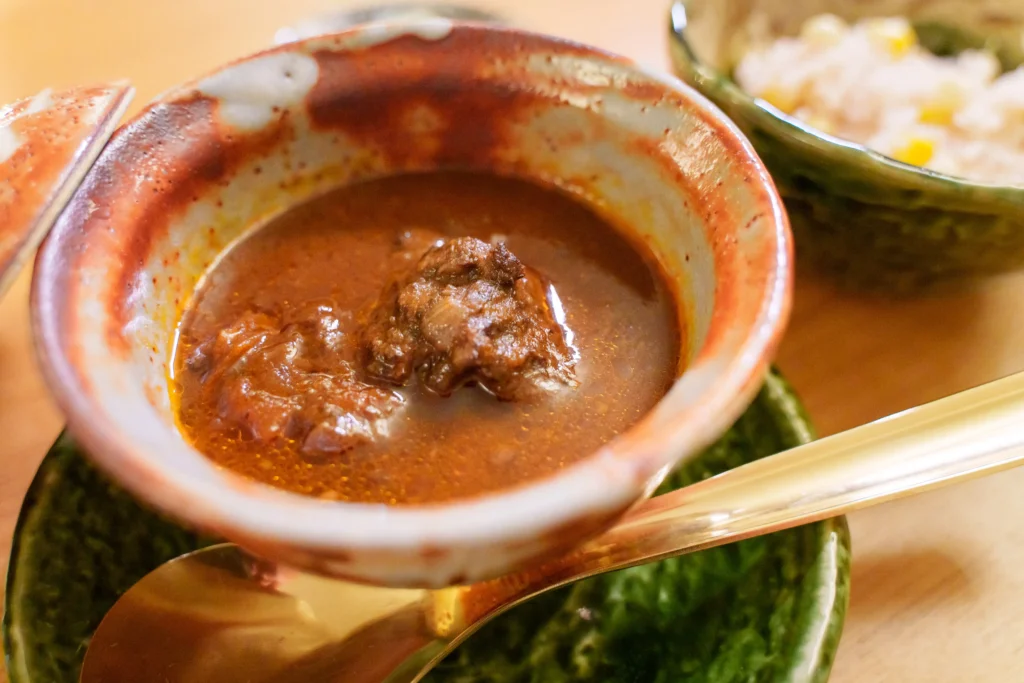
・Summer Monkfish Salt-Grilled and Marinated — lightly grilled with mountain salt to highlight its delicate flavor
・Fukushima Beef Lodge-Style Stew — tender local beef slowly simmered in a rich, comforting sauce.
・Homemade Roast Ham Shabu-Shabu — thinly sliced house-made ham cooked briefly in a light broth.
・Corn Takikomi Gohan — seasonal corn cooked with rice, infusing it with natural sweetness.
Seasonal flavors continue to appear one after another. None of the dishes rely on flashy presentation; instead, what stands out is the natural essence of the ingredients and the careful craftsmanship that brings out their full potential.
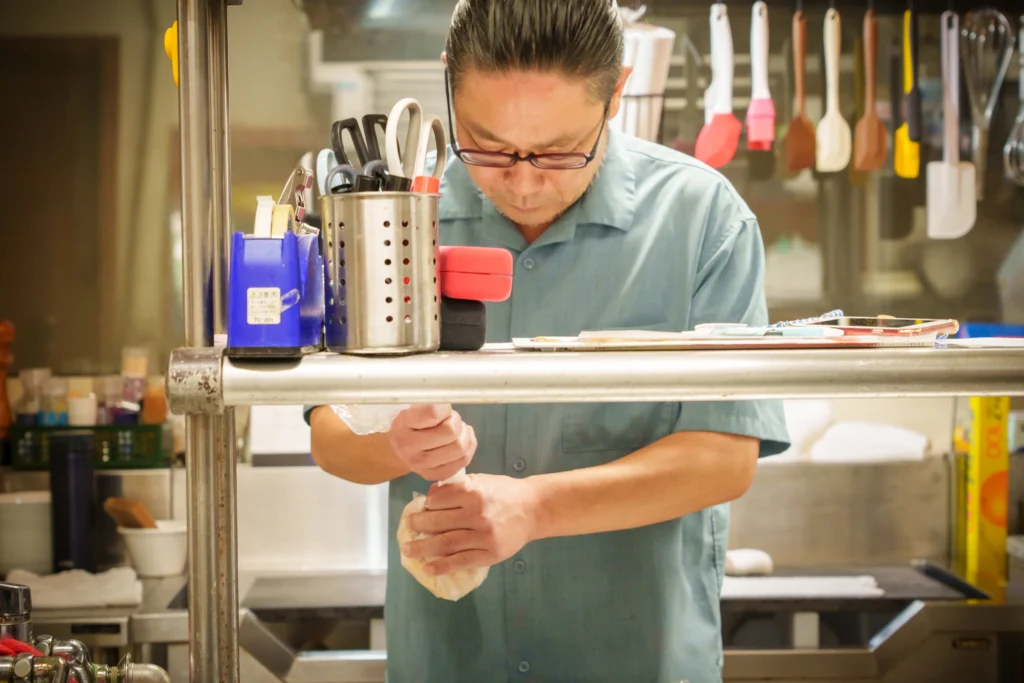
The head chef hails from Miyagi Prefecture and places utmost importance on his connections with local producers and fishermen.
“Even the same vegetable can taste different depending on who grows it. Farmers with well-tended fields produce vibrant, lively ingredients. When food is nurtured with care, it changes the flavor of the dish itself.”
The seri (water dropwort) used in the hot pot comes from an organic farm in Miyagi with whom the chef has worked long before seri-nabe became famous in the region. The seafood is delivered directly by a junior fisherman, who brings only what is needed each day. It’s this trust and close relationship with producers that forms the very foundation of the dining experience.
What impressed me even more was the chef’s dedication to rice and water.
At Numajiri, they use rice from a contracted farm in Inawashiro, carefully dried using the rare traditional “fusagake” (sun-drying) method. By taking the time for natural drying, the rice’s sweetness and aroma are greatly enhanced. For the corn rice, three types of corn are blended — sweet white, chewy red, and umami-rich yellow — then cooked according to the day’s weather and the expected timing of the meal to achieve optimal flavor and texture.The spring water from underground, ideal for pairing with the dashi broth, further enhances the taste of vegetables and seafood, creating a perfectly balanced foundation for the cuisine.
“Ingredients from Fukushima and the Tohoku region are naturally flavorful on their own. That’s why we avoid excessive seasoning.”

At the heart of the cuisine lies a philosophy of respecting the land and the seasons.
At this high-altitude location, the progression of the seasons differs from that of the Kanto region. For example, the sweetest corn comes after Obon (mid-August), when the cool mornings and evenings draw out the natural sugars in the vegetables. This creates a flavor of the season that can only be experienced here.
Cooking in the city is fine, of course, but here there’s a sense of change.
You can feel it every day — today it’s chilly, or autumn is approaching.
Because of that awareness, the cuisine can remain truly in tune with the seasons.”
The head chef also tends a small garden on the lodge grounds, and hopes to one day offer an experience where guests can harvest their own vegetables for breakfast. Living in harmony with nature and capturing the changing seasons on a plate — this dinner was more than just a meal; it was a moment to taste the very life of the land and the people who nurture it.
Onsen — Healing Surrounded by Forest and Breeze

With the lingering flavors of dinner still in mind, I made my way to the lodge’s onsen.
The baths are fed by Numajiri Motoyu, a hot spring with a history of approximately 400 years, flowing directly from the source. At an altitude of 1,250 meters, the strongly acidic sulfur spring boasts a pH of 2.1 — comparable to a lemon — earning it the reputation of a medicinal bath long valued for beauty and health.
The water clings gently to the skin, tightening it as you soak, and afterward, your skin feels remarkably smooth and supple.
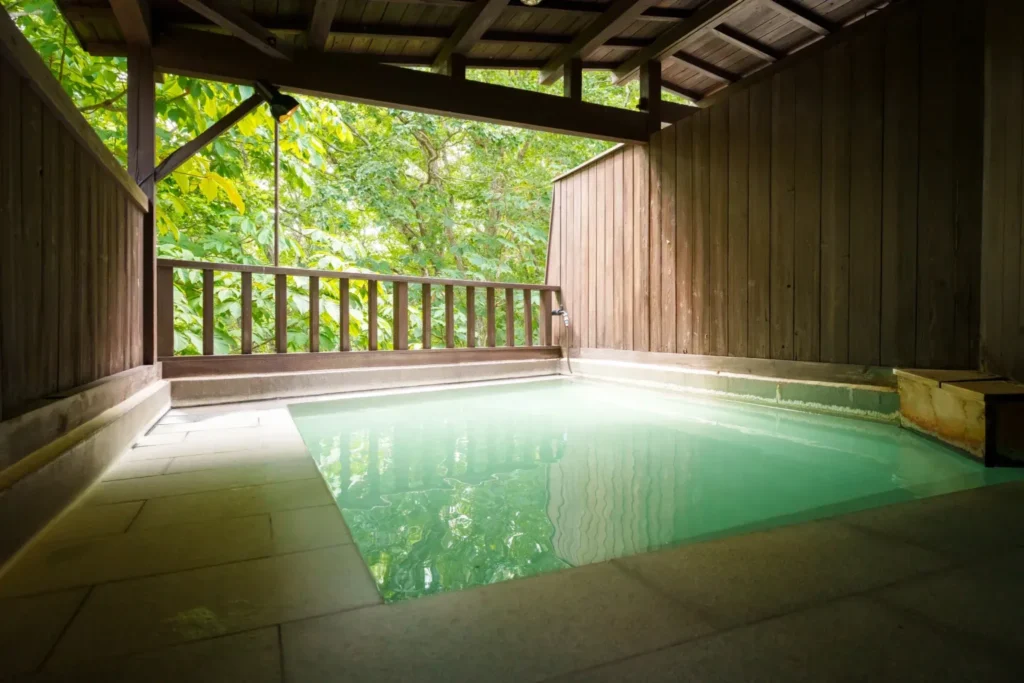
The indoor bath exudes a calm atmosphere, wrapped in the warm scent of wood, while the outdoor bath allows you to feel the crisp highland air and gentle breeze, creating a sense of unity with nature.
At night, a sky full of stars spreads above the rising steam, and if you listen closely, only the sounds of insects and the wind can be heard.
Closing your eyes, time seems to slow and unravel, offering a deeply restorative experience for both body and mind.
③Campfire — A Night of Reflection Amidst Silence and Nature
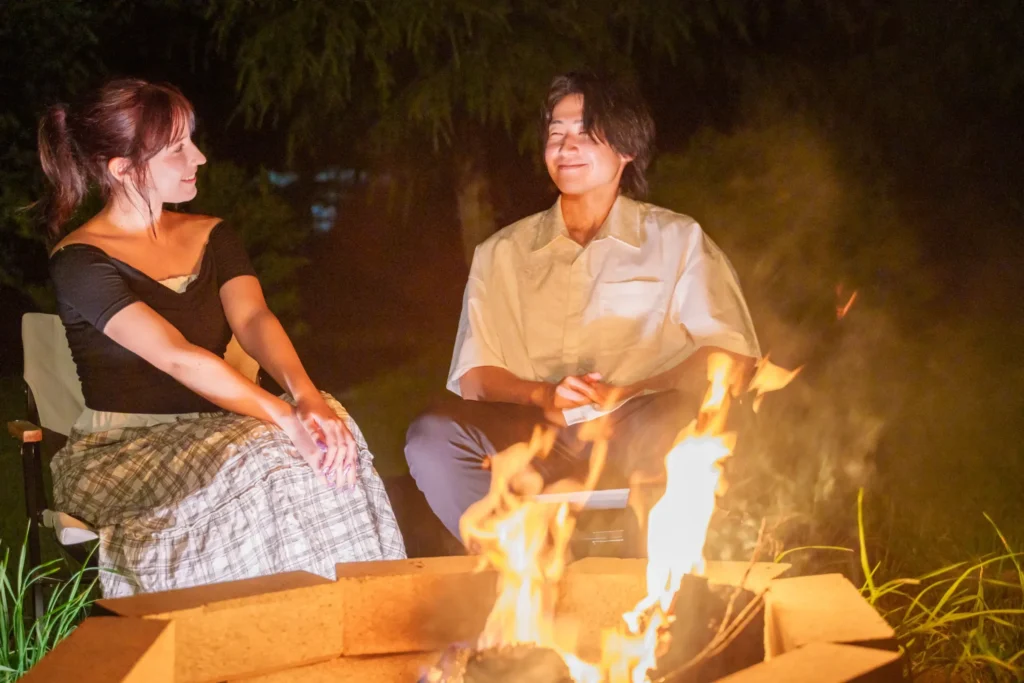
How about ending the night with a campfire in the lodge’s garden?
Beneath a pitch-black sky untouched by streetlights, the only source of light is the flickering flames of the fire.
As the wood crackles and pops, countless stars begin to twinkle overhead. The surroundings are astonishingly quiet — all you hear are the rustle of the wind, the chirping of insects, and the distant stillness of the mountains.
Sitting back in a chair and staring into the flames, a profound calm begins to spread through the depths of your mind.
In daily life, few of us have the chance to simply watch a fire burn, and that is precisely why this moment becomes an opportunity to quietly reflect on yourself and your journey. Without words, the fire and the night sky seem to speak to you, creating a strangely intimate and meditative experience.
Gathering around a fire — a primitive, instinctive act — quietly draws people closer to both nature and each other.
As time seems to slowly melt away, a rare sense of connection with the natural world seeps into the soul, offering an experience impossible to find in everyday life.
Extreme Onsen Experience — A Day That Shifts from Serenity to Adventure
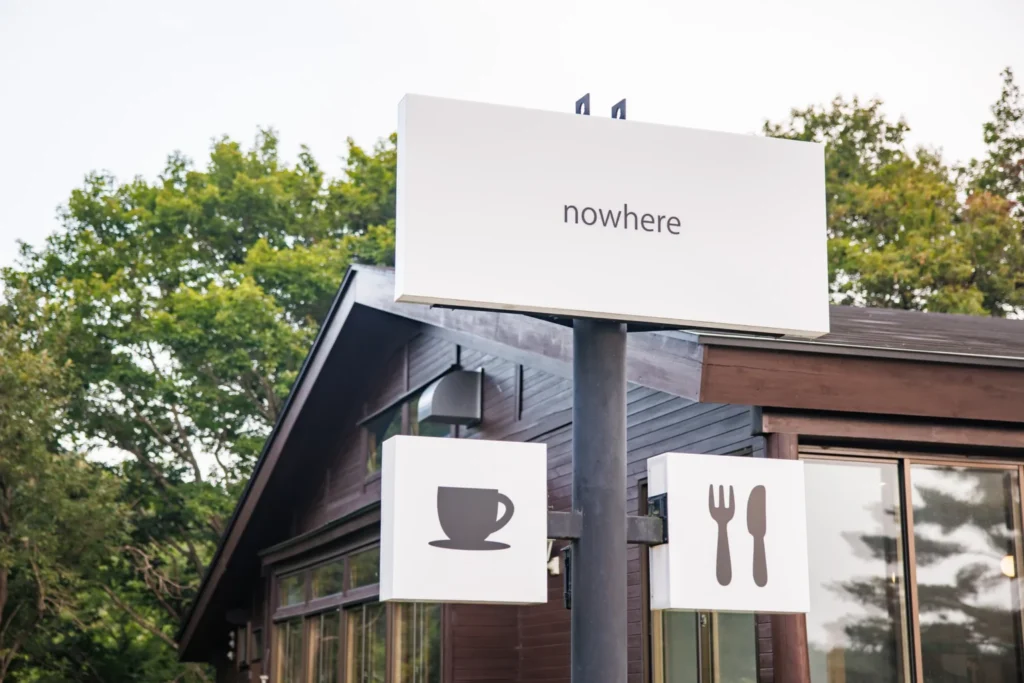
The next morning, we gathered at Nowhere, an outdoor base located right next to the lodge.
Originally the rest house of Numajiri Ski Resort, the oldest ski resort in Tohoku, it has been renovated into a café and activity center. Today, it serves as the starting point for a variety of experiences set against the backdrop of Numajiri’s vast natural landscape.
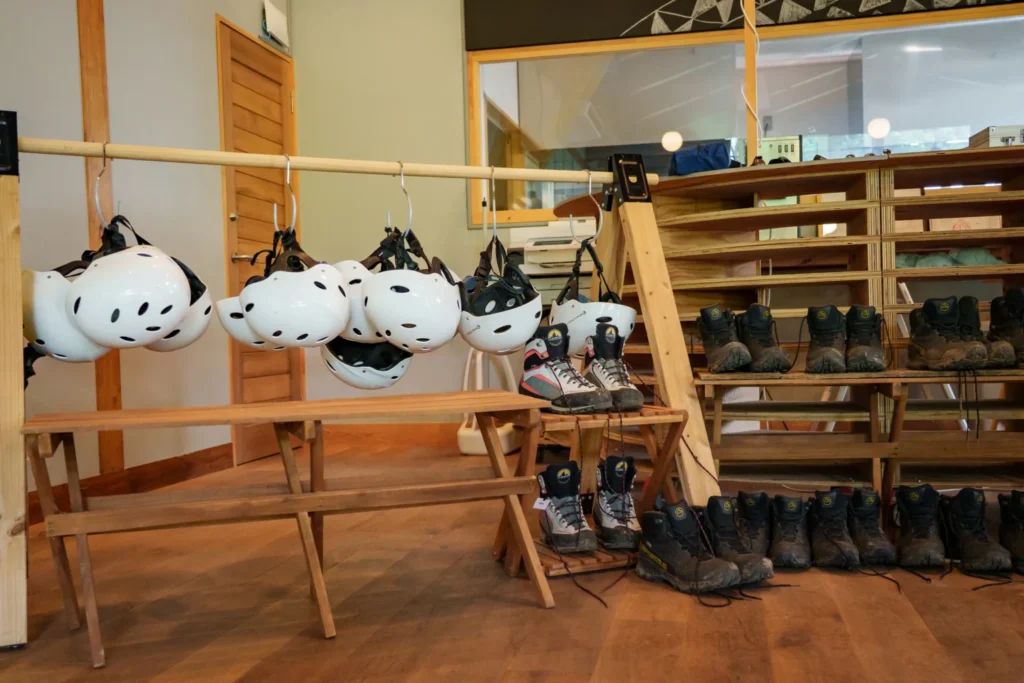
Stepping inside the wooden building, outdoor gear was neatly arranged, and maps and trail guides adorned the walls. Trekking shoes, poles, and other equipment are available for rent, and drinks and light snacks can also be purchased.
After the serene stay at the lodge, the atmosphere shifts — a palpable sense of adventure fills the air, making the heart race with anticipation.
The goal of the day was clear — the Extreme Onsen.
This special tour involves a roughly one-hour trek to the source of Numajiri Motoyu, located at an altitude of 1,300 meters, where participants can soak in a wild, natural hot spring. With swimsuits and towels ready, and after receiving instructions from the guide, the group set off into the mountains.
Trekking — The Adventure Begins Toward a Hidden Hot Spring
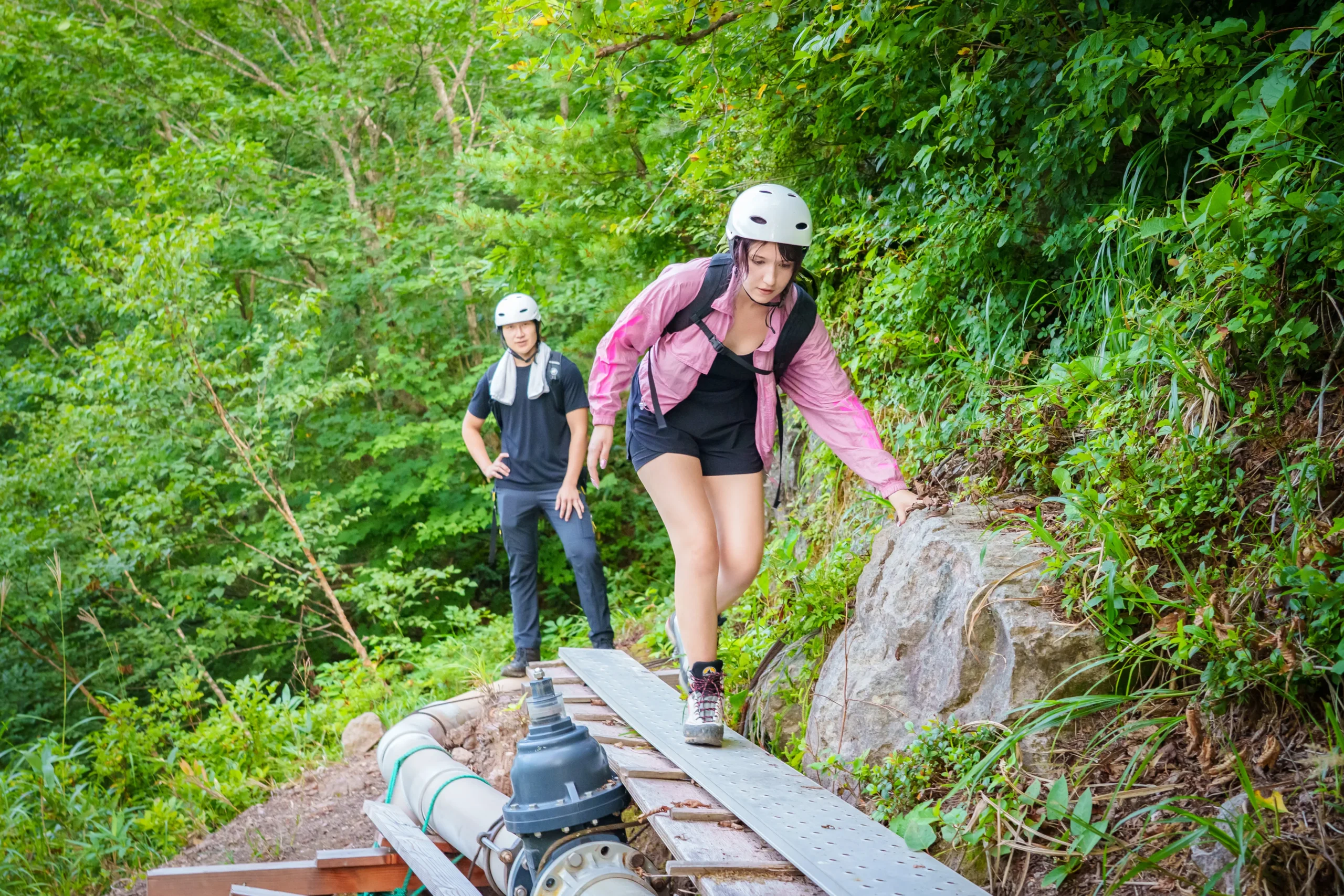
The trek began at a point a short drive up the mountain from the lodge.
When the guide instructed us to put on helmets, a rush of excitement hit — as if flipping a switch from everyday life to adventure mode.
The well-maintained mountain trail was easy to navigate, making it approachable even for beginners. As we walked through the trees, the guide shared stories about local plants and the terrain, allowing us to appreciate the richness of nature simply by moving along the path.
One moment that stood out was when I noticed a plant with striking green leaves streaked with red. Instinctively, I reached out to touch it — but the guide quickly stopped me.
“Don’t touch that one,” he warned. “If the sap gets on your skin, it can cause an itchy rash like hives.”
Simply brushing past it wouldn’t be an issue, he explained, but if the leaves rubbed against sweaty skin, the sap could trigger a reaction.
Moments like this reminded me how valuable these bits of “forest wisdom” are — small pieces of knowledge that bring a sense of safety in the wild.

Along the way, we passed scenic spots such as Shiraito Falls, where delicate streams of water cascaded down the rocks, and viewpoints offering sweeping sights of the Adatara Mountain ridgeline. Each time we stopped, I couldn’t resist lifting my camera — every frame looked like a postcard.
As the trail climbed higher, the air grew noticeably clearer, and I could feel each breath sink deeper into my lungs — a quiet reminder that I was getting closer to the heart of the mountains.
About thirty minutes into the hike, I suddenly noticed a change in the air — a faint scent of sulfur drifting on the breeze. As we continued along the trail, the forest opened up into a vast gorge, and below us, white steam rose gracefully from the valley floor.
That rising mist was none other than our destination — Numajiri Motoyu, the wild source of the Numajiri hot springs.
This area once thrived as a bustling hot spring resort, but over time, the effects of sulfur gas emissions and harsh natural conditions forced the inns to close and disappear.
Today, it remains a hidden sanctuary accessible only through guided tours.
Feeling the heat rising from the ground beneath my feet and watching clouds of steam swirl around the valley, I couldn’t help but feel my heart race with excitement.
Extreme Onsen
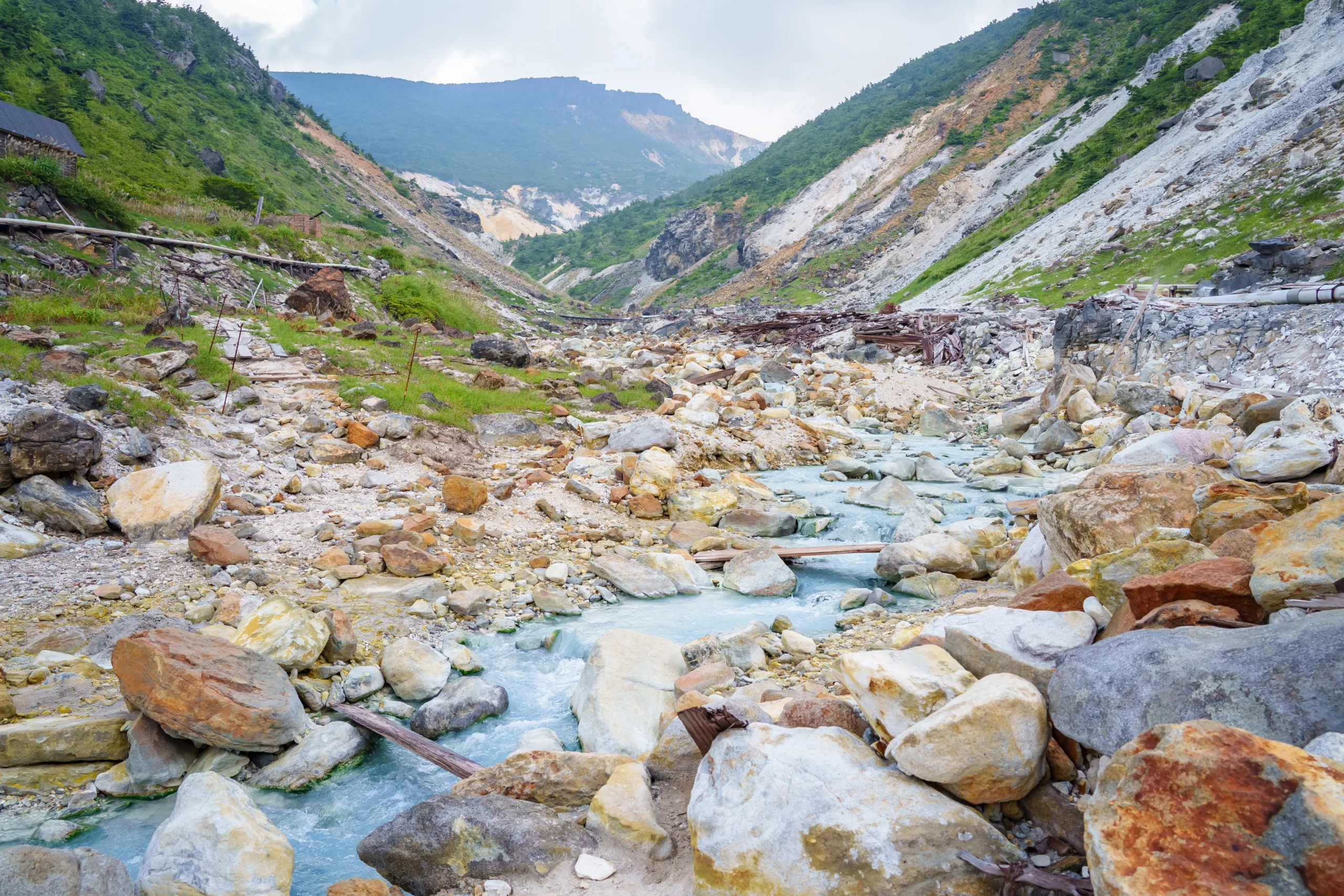
As we descended into the valley, the scent of sulfur grew stronger, wrapping us in the sensation of venturing deep into the very core of the earth. From cracks in the nearby rock, mineral water trickled down. At the guide’s suggestion, I took a sip — and was struck by its strong, metallic taste. It’s rich in iron, the guide explained, and apparently, when you’re overly fatigued, you can’t taste it at all — a curious little health check in the middle of the mountains.
Then, the scene before us suddenly opened up — and it was beyond anything I had imagined.
At the bottom of the gorge, a river of hot spring water flowed vigorously through the valley. When I dipped my hand into one of the side streams, it was nearly 60°C (140°F) — scalding hot. The sheer force of nature made it feel as though the earth itself was alive, constantly creating and releasing this boiling stream.
This hidden onsen can only be reached by joining a guided tour, limited to just two groups per day. True to its name, this was indeed the “Extreme Onsen.”
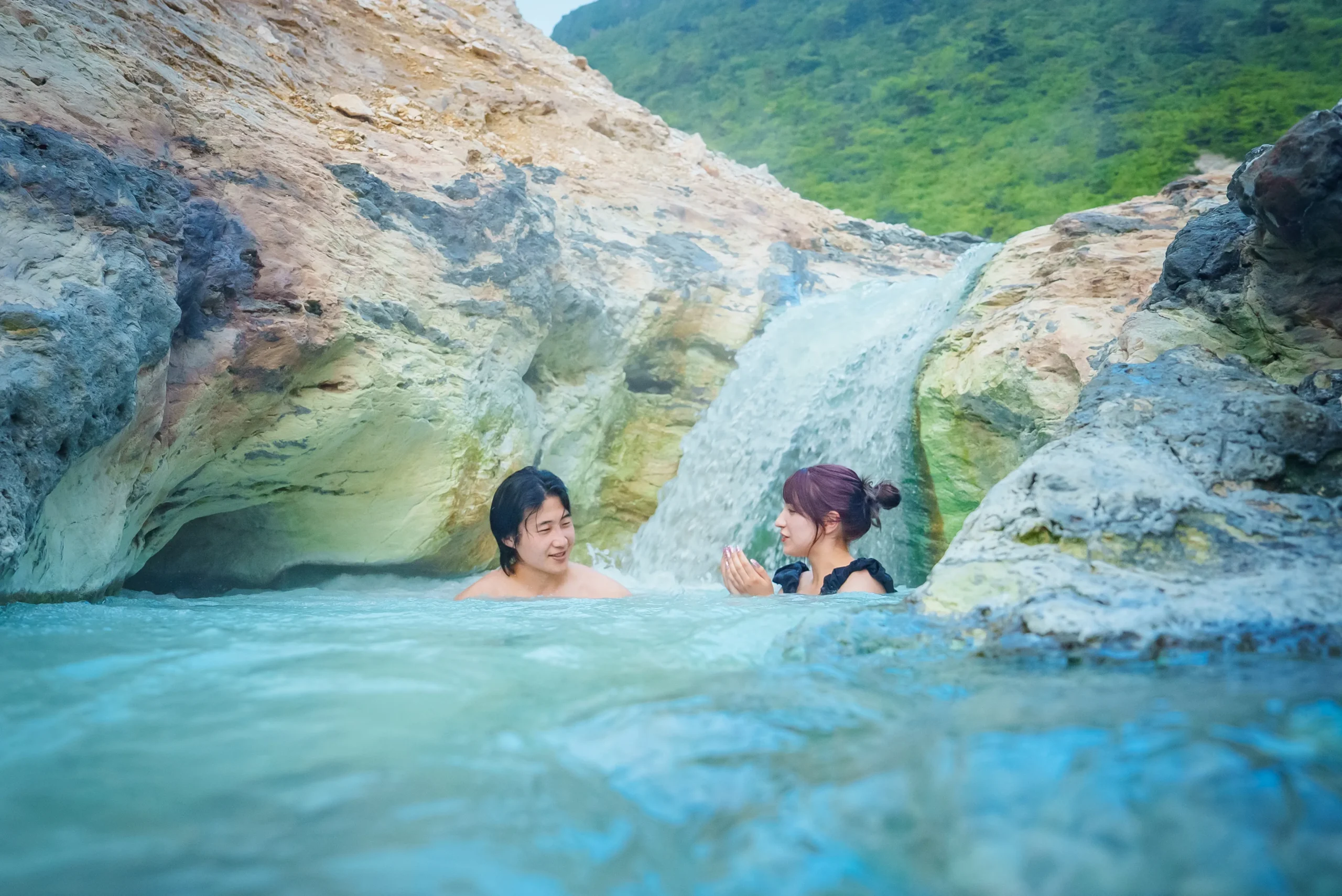
We changed into our swimsuits — time to enter the water.
Carefully, we made our way across the rocks and into the flowing stream.
The spot we stepped into was deep enough that even an adult could soak up to their chest— a natural hot spring basin formed entirely by the earth.
Rather than getting into a bath, it felt more like surrendering yourself to a warm river — a strange and wonderful sensation of becoming part of nature itself.
Even in midsummer, the air is cool at this high altitude.
But once I sank into the water, the gentle heat — carrying the distinct scent of sulfur — began to seep deep into my core.
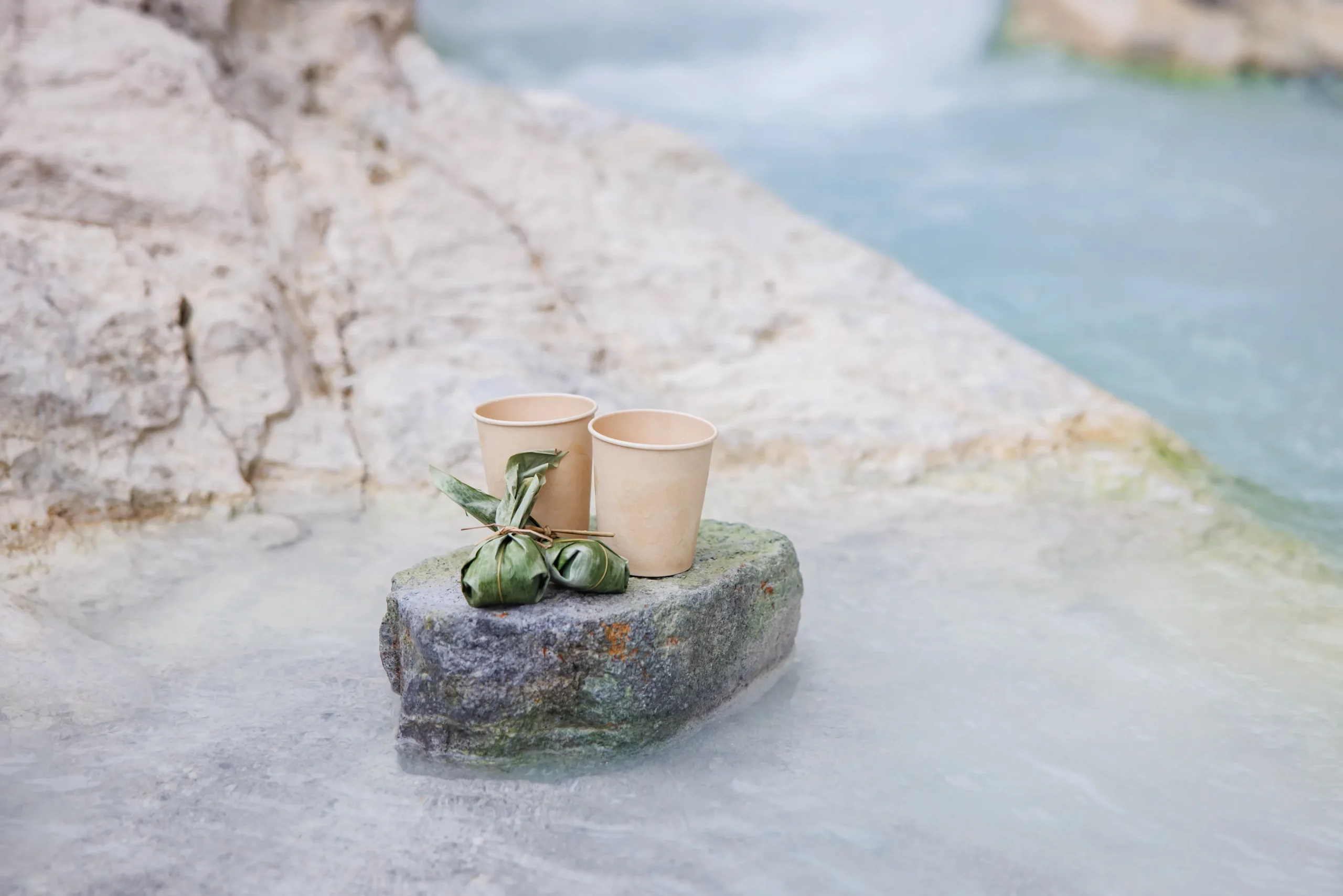
When I looked up, steep cliffs rose on both sides, and beyond them stretched a chain of distant mountains. In that ancient landscape carved over countless years, it felt as if only the hot spring and I existed — a moment of complete immersion in nature itself.
After soaking for a while, our guide kindly served us hishi-cha and sasa-dango.
Hishi-cha is a fragrant tea made by roasting the nuts of the water chestnut (hishi) harvested from Lake Inawashiro. Its gentle sweetness spreads through the body, warming you from the inside as you sip it in the hot spring.
The sasa-dango — a local sweet made of mugwort-flavored rice dough filled with red bean paste and wrapped in bamboo leaves — offered a simple, nostalgic sweetness that perfectly matched the mountain air and faint scent of sulfur.
Wrapped in rising steam, we chatted with our companions—or simply sat in silence, gazing at the valley before us.
It was an experience far beyond what any open-air bath could offer—an extreme onsen in every sense, where nature, heat, and stillness converged into something unforgettable.
Even for someone like me, who has visited countless hot springs across Japan, this experience was without question the best I’ve ever had.
The sensation of becoming one with nature—and the undeniable sense of exclusivity that can only be found here—etched this memory deeply into my heart.

As we reluctantly left the hot spring and began our return journey, a quiet sense of fulfillment filled the air.
The trail back was steeper and more rugged, but the reward was a breathtaking panorama—endless layers of mountains merging with the vast sky.
Along the way, I noticed steel beams and cables stretching across the valley. Our guide explained that these were remnants of the old infrastructure, once used to transport supplies when the hot spring area was a thriving resort—and that even today, they’re occasionally used for hauling goods.
The descent, bathed in the light of the highland sun, felt like walking through the lingering heartbeat of nature itself—a contemplative, soul-stirring end to this extraordinary adventure.

After returning to the lodge, you can unwind at the adjoining Nowhere Café.
Many guests sit by the large windows, savoring a cup of the café’s signature dark-roast coffee while gazing out over the sweeping highland meadow.
Inside, shelves are lined with local specialties such as hishi-cha (roasted water caltrop tea from Lake Inawashiro) and exclusive “Extreme Onsen” merchandise—stickers, T-shirts, and more. The stylish designs make for the perfect memento of this unforgettable journey.
(Photo: Extreme Onsen T-shirt?)
A stay at the tranquil lodge and an adventure into the wild hot spring—two completely contrasting journeys experienced in a single trip.
Your body is wrapped in a pleasant fatigue, while deep within, a quiet sense of accomplishment and a lingering afterglow remain.
A stay wrapped in the quiet calm of the lodge, and an encounter with the raw power of nature at the wild hot spring—
two completely opposite journeys, experienced in a single trip.
Your body is gently enveloped in a pleasant fatigue, while deep inside, a quiet sense of fulfillment and an unforgettable afterglow remain.
▷Learn more about the Extreme Onsen
Additional Information
- The Extreme Hot Spring Tour is available only from May to November (a different event is held during the snowy season).
- The trekking route takes about 3 hours round trip. Bring comfortable shoes, a towel, and swimwear.
- Shuttle service is available from Inawashiro Station (advance reservation recommended).
- The café is open only on weekends and public holidays.
- Due to sulfur gas, entry is not permitted without a guide.
Numajiri Kogen Lodge and the Extreme Hot Spring offered a rare experience in Japan
—a perfect harmony of stillness and motion, healing and adventure.
At the quiet lodge embraced by the forest, I let my body and mind unwind. The next day, I trekked through the mountains, descended into the valley, and immersed myself in a wild open-air hot spring.
The way these two contrasting moments flow seamlessly together within a single journey—that, I realized, is the true charm of this place.
At the lodge, guests can enjoy campfires under starry skies, meals crafted from local ingredients, and a hot spring that seems to melt into the forest itself.
While it preserves a distinctly Japanese sense of charm, the lack of excessive embellishment allows you to feel closer to nature.
Then, the next day, you venture deeper into that very nature on your own two feet.
It felt as though two stories—one of peaceful retreat and one of gentle adventure—were woven together into a single journey.
This place comes highly recommended not only for lovers of hot springs and nature, but also for those who want to enjoy both culture and outdoor activities.
Here, you can experience a genuine journey—immersing yourself in nature in a way that no easily accessible tourist spot can offer.
The lingering scent of steam, the glow of the night fire, the vast expanse of stars above— with these memories of nature etched into every sense, I found myself longing to return to this place someday.
It was a journey that left a deep and lasting impression on the heart.

